The 1971 Lincoln cent is widely available due to heavy hoarding by investors during that time. As a result, most of these coins are easy to find in circulation today and typically carry low value. However, coins that remain in mint condition — especially those with high grades — can be worth significantly more and are sought after by collectors.
In 1971, three U.S. Mints struck Lincoln cents featuring the Lincoln Memorial reverse. The Philadelphia Mint produced coins without a mint mark, while the Denver Mint issued standard circulation coins with the “D” mint mark. Meanwhile, the San Francisco Mint struck both regular strike coins and proofs, which were specially made for collectors.
1971 Lincoln Penny Value Chart (Red Coins – RD)
| Grade | 1971 No Mint Mark | 1971-D (Denver) | 1971-S Proof (San Francisco) |
|---|---|---|---|
| MS 65 | $22 | $22 | $18 |
| PR 65 | – | – | $8 |
Values are for coins graded as Red (RD), indicating full original mint luster.
The 1971 Penny History

The very first U.S. one‑cent coins bearing Abraham Lincoln’s portrait were issued in 1909, replacing the long‑running Indian Head design to honor his 100th birthday. From that moment on, Lincoln’s profile has graced the obverse of every cent.
Lincoln—often hailed as one of America’s greatest presidents—served a five‑year term in the White House, guiding the nation through its darkest hours and securing freedom for the enslaved.
1971 Lincoln Cent Varieties & Mintage
| Mint | Coin Type | Mintage |
|---|---|---|
| Philadelphia | 1971 (no mint mark) | 1,919,490,000 |
| San Francisco | 1971‑S circulation | 525,133,459 |
| San Francisco | 1971‑S proof | 3,220,733 |
| Denver | 1971‑D circulation | 2,911,045,600 |
| Total (all) | — | 5,358,889,792 |
The original cent design was crafted by Victor David Banner, whose “barber‑style” Lincoln portrait endured unchanged until 1959. Fifty years after the 1909 debut, artist Frank Gasparo redesigned the reverse, replacing the wheat ears with an image of the Lincoln Memorial—complete with the seated statue.
Over the decades, Lincoln cents also saw changes in metal content: they began as 95% copper, shifted temporarily to zinc‑plated steel in 1943 due to wartime needs, and soon returned to a copper alloy.
In 1971, all Lincoln cents carried Frank Gasparo’s Memorial reverse. That year’s output—over 5.3 billion coins across three mints—is also notable for a surge of DDO (Doubled Die Obverse) errors, particularly from the Philadelphia and San Francisco facilities.
Features of the 1971 Lincoln Penny
The 1971 Penny obverse
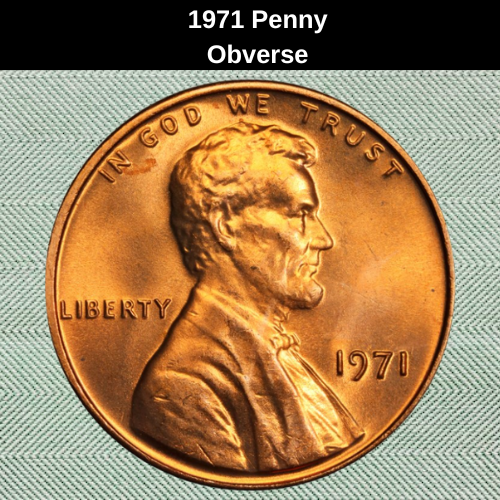
The obverse design of the penny remains unchanged since 1909, when it was first created by Victor David Brenner. As with other coins in the series, the 1971 Lincoln cents feature a prominent bust of Abraham Lincoln as the central design element.
Lincoln’s portrait faces right and is placed in the center of the coin, surrounded by key inscriptions. The motto “IN GOD WE TRUST” arches along the top edge above his head. On the left, behind Lincoln’s neck, the word “LIBERTY” is inscribed.
To the right, in front of his chest, appears the year “1971”, with a mint mark—either “D” for Denver or “S” for San Francisco—just below the date. If there’s no mint mark, the coin was struck in Philadelphia.
Additionally, you can find the initials “VDB” on the lower edge of Lincoln’s shoulder, honoring Victor David Brenner, the original designer of this iconic cent.
The 1971 Penny reverse
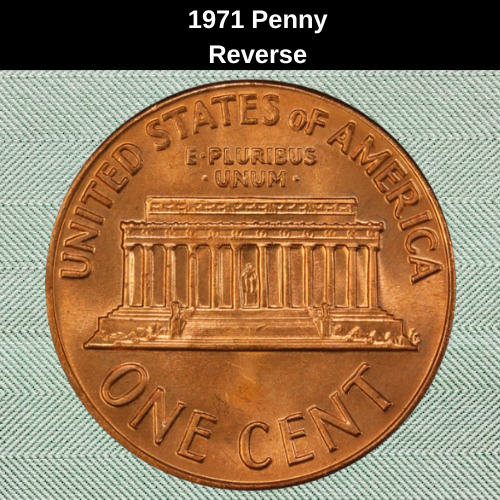
The Lincoln Memorial in Washington, D.C., was completed in 1921, but its image—with Lincoln’s seated statue visible—didn’t appear on the penny’s reverse until 1959, marking the 150th anniversary of Lincoln’s birth.
Above the Memorial is the Latin motto “E PLURIBUS UNUM”, written in two lines, symbolizing the unity of the many states into one nation. The phrase “UNITED STATES OF AMERICA” arches along the upper rim, while the denomination “ONE CENT” is inscribed along the bottom edge.
This reverse design was created by Frank Gasparo, and his initials “FG” are visible in the lower right corner near the base of the Memorial.
1971 Lincoln Penny – Key Specifications
| Feature | Details |
|---|---|
| Composition | 95% copper alloy with zinc or tin |
| Diameter | 1.75 inches (19.05 mm) |
| Weight | 0.10970 ounces (3.11 grams) |
| Thickness | 0.03937 inches (1 mm) |
| Edge | Plain |
| Shape | Round |
| Face Value | One cent ($0.01) |
Other Characteristics of the 1971 Penny
The 1971 Lincoln cents are round coins with a smooth (plain) edge. They were struck in a copper-based alloy, giving them their classic appearance in red, red-brown, or brown tones—each color depending on the level of oxidation and coin preservation over time.
1971 Lincoln Penny Grading
Grading is the process of evaluating a coin’s physical condition to determine its collectibility and market value. Factors such as scratches, contact marks, holes, luster, and the overall state of the dies used during minting all influence the final grade.
Coins in Poor (P-1) condition are heavily worn and lack most design details—these are typically not collectible. On the opposite end, coins graded as Mint State (MS-70) are considered to be in perfect, uncirculated condition, showing no signs of wear or handling.
Official Lincoln Penny Grading Scale
| Grade | Description |
|---|---|
| 1 | Basal State-1 (Poor) – Barely identifiable |
| 2 | Fair – Major design features visible |
| 3 | Very Fair – Slightly clearer details |
| 4, 5, 6 | Good (G) – Heavily worn but readable |
| 7, 8, 10 | Very Good (VG) – Major features visible |
| 12, 15 | Fine (F) – Moderate wear, clear details |
| 20, 30 | Very Fine (VF) – Light wear on high points |
| 40 | Extremely Fine (EF/XF) – Light circulation wear |
| 50 | About Uncirculated (AU) – Slightest traces of wear |
| 60 | Mint State (MS-60) – No wear, noticeable flaws |
| 65 | Mint State (MS-65) – Strong strike, few marks |
| 70 | Mint State (MS-70) – Perfect, flawless coin |
📌 Tip: Be sure to consult professional grading guides or services to determine your coin’s accurate grade. It’s a crucial first step in knowing the true value of your 1971 Lincoln penny.
1971 Penny Value Guides
1971 No Mint Mark Penny Value
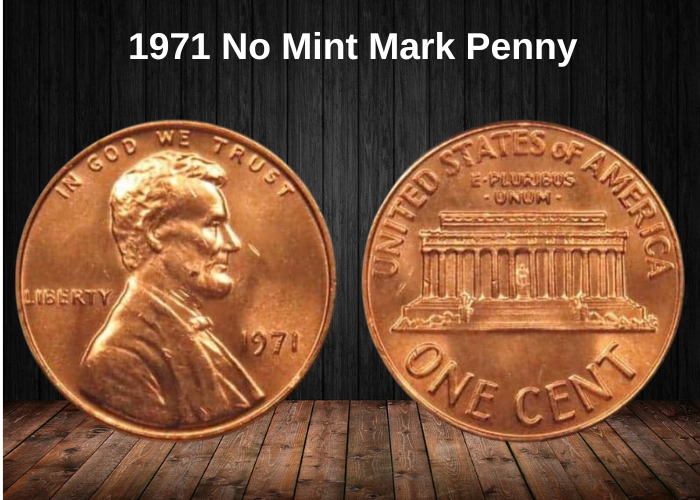
Most 1971 Lincoln cents without a mint mark—meaning they were minted in Philadelphia—are common and hold modest value, especially in circulated condition.
- In Mint State 60 (MS 60), these red-colored coins are typically worth around $0.20.
- For higher grades like MS 65, prices range between $11 and $22, depending on eye appeal, luster, and strike quality.
- The most valuable examples are graded MS 67 Red (RD), which average around $185 in the collectors’ market.
Auction Highlight:
One particularly well-preserved MS 67+ Red specimen sold for a remarkable $4,406 at Heritage Auctions in June 2014—showing that coins of exceptional quality can far exceed the usual market value.
1971 D Penny Value
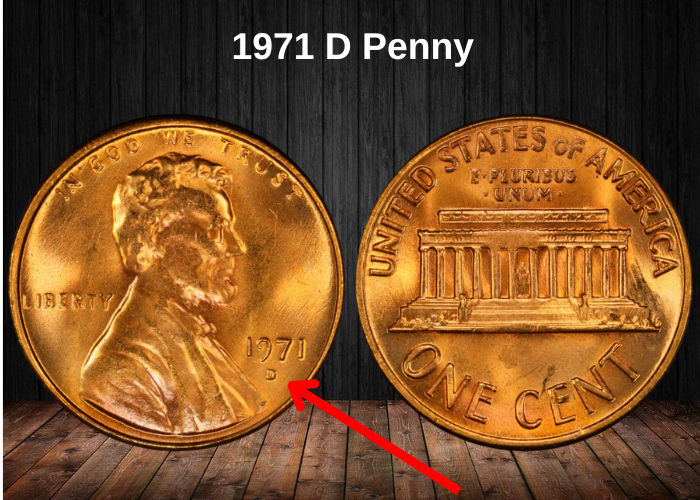
1971 Lincoln cents with the “D” mint mark—struck at the Denver Mint—are generally common and have modest market value in lower uncirculated grades.
- In Mint State 60 (MS 60), red 1971-D pennies are valued at around $0.20, just like their Philadelphia counterparts.
- Higher-grade coins in MS 63 to MS 65 typically range from $6 to $22, remaining affordable for most collectors.
- MS 66 Red (RD) examples are more desirable and are valued at about $35.
The top-known grade for this coin is MS 67 RD, and these pieces carry a market value of roughly $275.
Auction Highlight:
One MS 67 Red 1971-D penny reached a notable price of $1,380 at auction in August 2007, showcasing how premium-grade examples can command impressive prices beyond standard estimates.
1971 S Penny Value

1971 Lincoln cents with the “S” mint mark, minted in San Francisco, are common in circulated condition and are typically worth only their copper melt value.
However, in uncirculated (red) condition, their value increases:
- MS 60 Red (RD) examples start at around $0.30.
- Higher grades, such as MS 63 to MS 65, range between $10 and $18.
- A red MS 66 penny is usually valued at approximately $34.
The most sought-after specimens are those graded MS 67 RD, with an estimated market value of around $340.
Auction Highlight:
The highest-known grade, MS 67+ Red, saw an exceptional sale when one such coin sold for $4,500 on eBay in 2013—demonstrating that standout examples can bring in premium prices far above guidebook estimates.
1971 S proof Penny Value
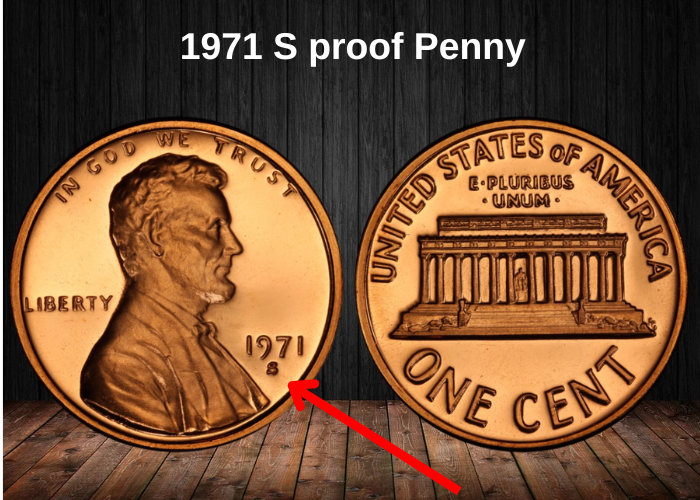
Proof pennies from 1971 were specially struck at the San Francisco Mint for collectors and are generally affordable, except for a few ultra-high-grade examples with deep cameo contrast.
- Most regular proof coins are valued between $4 and $6, depending on color tone and grade.
- PR 68 specimens—especially those with strong visual appeal—can fetch up to $140.
- The highly desirable PR 69 DCAM (Deep Cameo) coins are estimated at around $1,850 due to their exceptional sharpness and contrast.
Auction Highlight:
The record sale for a 1971-S proof penny occurred in 2014, when a PR 69 Deep Cameo example sold for an astonishing $17,250—making it the most valuable coin in the entire 1971 Lincoln penny series.
Rare 1971 Penny Errors List
DDO
The 1971 DDO (Double Die Obverse) Lincoln cent from Philadelphia is a notable error coin and highly collectible, especially in uncirculated red condition. These coins are found in three color designations: Brown (BN), Red-Brown (RB), and Red (RD)—each affecting value.
- Brown (PR 60) examples typically start at $100.
- Higher-graded coins, especially in PR 66, can command over $1,000 depending on eye appeal and strike clarity.
- The most desirable Red (RD) examples in PR 66 can reach estimated values of up to $1,800.
Auction Highlight:
A Red PR 66 DDO Lincoln cent reached a record price of $14,950 at Stack’s Bowers in November 2011, making it one of the most valuable 1971 Lincoln cents ever sold.
Struck-Through Error on 1971-D Lincoln Penny
A struck-through error occurs when a foreign object—such as debris, grease, or a piece of metal—gets trapped between the die and the planchet during the coin striking process. This object leaves a distinct impression or pattern pressed into the coin’s surface.
In the case of the 1971-D Lincoln cent, a struck-through error on the reverse side is noticeable by unusual marks or shapes caused by whatever material was caught during minting.
Notable Sale:
One such 1971-D struck-through error penny sold for $74 on eBay in 2020, illustrating the collector interest in this type of minting anomaly.
Where to sell your penny?
Now that you know the value of your penny, you might be wondering where to sell it. Don’t worry: here’s a guide to some of the best online platforms where you can easily sell your coins, along with their advantages and disadvantages.
Discover the best platforms for selling coins online (pros and cons).
FAQ about the 1971 Lincoln Penny
1. What major change happened to the Lincoln penny in 1971?
In 1971, the U.S. Mint began producing the Lincoln penny with a new composition: a clad core made of 99.2% copper and 0.8% tin and zinc, sandwiched between two thin layers of pure copper. This change was part of a larger effort to reduce copper usage during the Vietnam War and to cut production costs. The 1971 penny was among the first to use this clad copper composition, marking a major shift from the traditional 95% copper, 5% zinc pennies that had been produced for decades.
2. How does the 1971 penny differ visually and physically from earlier pennies?
Visually, the 1971 Lincoln penny looks almost identical to earlier issues with the Lincoln portrait on the obverse and the Lincoln Memorial on the reverse. However, the weight is slightly less — the 1971 clad penny weighs about 2.5 grams, compared to the traditional 3.11 grams of the solid copper pennies minted prior to 1971. This difference in weight and composition can be detected using a scale or specialized coin-testing equipment, but is not visible to the naked eye.
3. Were there any significant mint errors or varieties for the 1971 penny?
Yes. The 1971 penny has several known varieties and mint errors that collectors watch for. Notably, the 1971-S Doubled Die Obverse (DDO) is a famous variety where the date and lettering on the obverse are doubled, caused by a misalignment during the die-making process. This error is highly sought after by collectors and can significantly increase the value of the coin. Other errors such as die cracks, off-center strikes, and clad layer irregularities are also known for this year.
4. What is the mintage for the 1971 Lincoln penny, and how does it affect its rarity?
The total mintage for the 1971 Lincoln penny was approximately 3.06 billion coins produced across the Philadelphia, Denver, and San Francisco mints. This high production volume means the 1971 penny is generally not rare and is commonly found in circulation. However, coins with errors, proofs, or in uncirculated condition may be more valuable. The 1971-S Doubled Die Obverse variety is an exception, as it is rarer and can be worth significantly more.
5. How does the 1971 penny’s composition impact its value and collectibility today?
The clad composition introduced in 1971 means these pennies are less valuable as metal compared to the previous solid copper pennies. However, their collectibility lies more in condition and errors rather than intrinsic metal value. Uncirculated examples or those with minting errors like the Doubled Die Obverse are sought after by collectors and can command prices from a few dollars to several hundred dollars depending on condition and rarity.
6. What should collectors look for when authenticating a 1971 penny?
Collectors should check the mint mark (found under the date), the date font size and style, and especially inspect for any doubling on the date and lettering if interested in error varieties. The coin’s weight can also help confirm whether it is a true 1971 clad penny or a counterfeit. Careful examination under magnification can reveal details about die cracks or doubling. Using a reputable grading service for authentication is recommended for high-value coins.
7. How does the 1971 Lincoln penny fit into the broader Lincoln Memorial penny series?
The 1971 Lincoln penny marks a transitional period within the Lincoln Memorial series (1959-2008) because of its new clad composition. It reflects the U.S. Mint’s response to economic pressures while continuing the longstanding Lincoln Memorial design. For collectors focused on the series, the 1971 penny is important for understanding the shift in materials and is a key year for spotting varieties and errors unique to this composition change.


















































